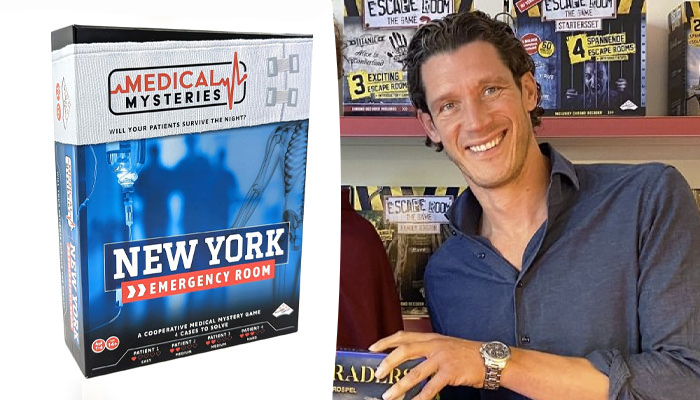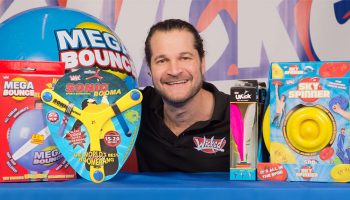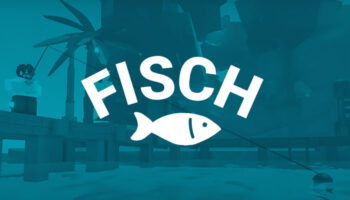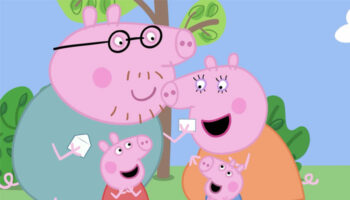Identity Games’ JM Duparc on the one-line pitch that sold him Medical Mysteries

JM, it’s always great to catch up. You’ve recently launched Medical Mysteries, a collaboration with the invention studio Bluematter Games. How did they initially pitch the game?
Well, Nic and Rebecca walked into the meeting with a very big suitcase. I said: “Wow, you have a lot to show me!” And they said: “No, we have nothing to show you because everything in this suitcase is a working prototype.”
Right – because you prefer to see things that aren’t fully formed yet?
That’s right.
So was that meeting over!?
No! They instead had an elevator pitch for me… They said: “Let’s make an escape room type of game but centred around a medical mystery.” I was like, holy shit, this is the best idea I’ve heard!
And that was it! Sold on that one-liner?
Yes! It left things open, so we could sit down and continue blurting out ideas to each other. By the end of that meeting, we were high fiving; we thought it was gold. After the meeting, I called my two partners and said: “Guys, I have the next really big thing!” Whenever I ran into Nic and Rebecca at that show, we’d share new ideas for the game. By the end of the show, we had a good idea of how we wanted the game to be.

Amazing. And in some ways, that flies in the face of what is expected from inventors in a meeting. No sizzle… No sell sheet… No prototype!
If we are invested early on, and get to put our heart and soul into a game, they usually result in our biggest successes. We are game developers ourselves, so if we see a finished product… It might be fantastic, but what can we add?
If you have a finished, working, perfect prototype, there are other companies out there that can do a better job of bringing that to market than we do… But if you have a diamond of an idea that has real potential, we’re a really good fit to hear about it. I have a great imagination – I don’t need a working prototype to see how something works.
As a result of speaking with Nic and Rebecca about this idea at such an early level, I could contribute some good ideas that helped in the game’s development. And they were inspiring us as well. Being in that creative space with these two creative people made for such a fun, inspiring development process.
Does the inventor community know this is your preferred approach? Are you seeing less prototypes and more elevator pitches?
More and more. And it means I’m getting to see more ideas now; that’s the great thing. Rather than playing through two or three prototypes in a meeting, I’m now getting through 15 or 20 elevator pitches in 30 minutes. We’ve actually signed a deal on a game – which we’ll be showing at DISTOY – and that was just a name! The name inspired us to such a degree that we went with it.

Wow! Let’s be sure to check back in on that when you can talk about it. Now, back to Medical Mysteries. This game has a bit of a ‘Choose Your Adventure’ format, so I imagine it was quite a complicated development process? Not to mention keeping it medically accurate!
Nic and Rebecca had made numerous Escape the Room games for ThinkFun, and we of course have our Escape Room: The Game series. We both know what it’s like to make a game like this; that trust and experience was there. We also wanted to make sure it was medically accurate, but that players would need no medical background to be good at the game.
And most escape room games are very linear. You solve a puzzle, you move onto the next puzzle… You’re not really in control. I loved the Choose Your Adventure books as a kid, so we thought implementing that into Medical Mysteries would make it unique in this category. In this game, when a patient is brought in, there’s like 20 different choices you can make… Are you going to talk to the patient? If yes, what are you going to ask him? Will you put him on morphine right away? Will you test his blood? Will you do a CT scan? There’s lots of options and that makes for fun discussions in the game.
Were there any big creative challenges involved here that you were proud – and relieved – to overcome?
Yes! Making all those options possible without making it a complicated game. That was vital. And like in any good episode of House, there’s a plot twist… A moment where you look at each other with goosebumps… We wanted to have those moments in the game, but they had to be medically accurate. So we’d think of stuff and then chat with medical experts who would steer us to an accurate version of that.
Also, I have to give a shout out to one of our designers – Wouter van Oldeneel tot Oldenzeel. He checked every single detail in the game and made sure everything was right… Every code, every diagnosis… And also added ideas himself! He did a great job.

Well done Wouter! You mentioned it being a unique theme, which it is – but unique can also sometimes mean risky. TOMY, Kosmos and Buffalo are on board and excited about this, so what do you think has enabled it to be unique, without being ‘out there’ or risky?
In all honesty, these things always remain a gamble. You have no idea if it will work or not, but the reaction to this game has been amazing. It reinforced our belief that this game can be something really big…
But to answer your question, hospital shows have been big for decades. And if you’re watching House or Grey’s Anatomy, you always ‘play along’. It feels like a logical idea to bring this into games, especially with the popularity around story-driven games… It feels like the right time. There’s also a level of trust around us due to what we’ve done with Escape Room: The Game – that really helped.
JM, this has been insightful! Before we wrap up, what does the future hold for the Medical Mysteries brand?
We absolutely want to do more games in this series. We’ve almost finished the next edition, called Medical Mysteries: Miami Flatline. That will be out later this year. The storylines for the third game have been written… We’re also working on a historical one. There’s lots of places we can go with this.
You mentioned House and Grey’s Anatomy earlier. Do you think there’s a direct link to a tv show?
Definitely. We’ve had multiple production companies reach out about that. The want to turn the game into an actual tv show! We’ll be making a decision on that this week as it happens!
Amazing. We’ll keep an eye out. And away from Medical Mysteries, what else should we look out from Identity this year?
Battle Royale. That’s another game based on a huge trend – the battle royales you see in things like Squid Game, Fortnite, Call of Duty… We’ve made a spectacular game where you start with 100 figurines and only one will survive. The board actually explodes and becomes smaller and smaller as you play. Buffalo, TOMY and Kosmos have all taken it.

Great stuff. I have one last question. For any inventors reading, what sorts of concepts are you currently interested in seeing – or hearing – from them?
We try to have the game that stands out most in each category – and the best way to realise that is to create a new category, like we’ve done with Escape Room and Medical Mysteries. Sometimes these categories don’t make it, but that’s the risk we’re willing to take to be innovative. If we hear about a game trend, that’s not a reason for us to hop on board. That’s a reason for us to find a new one.
Fantastic. Thanks again JM, and congrats again on Medical Mysteries.
–
To stay in the loop with the latest news, interviews and features from the world of toy and game design, sign up to our weekly newsletter here

























